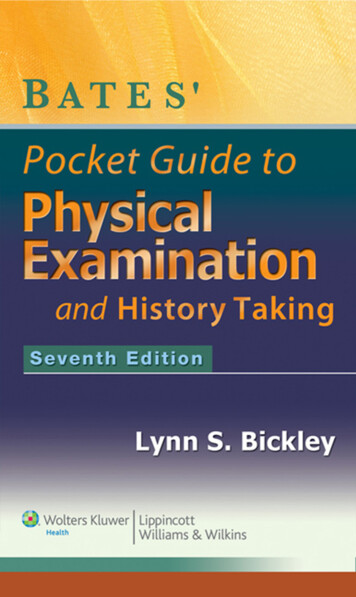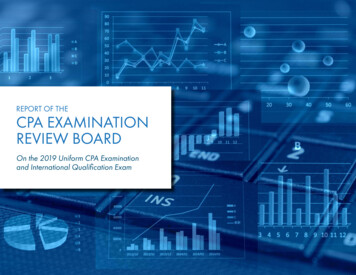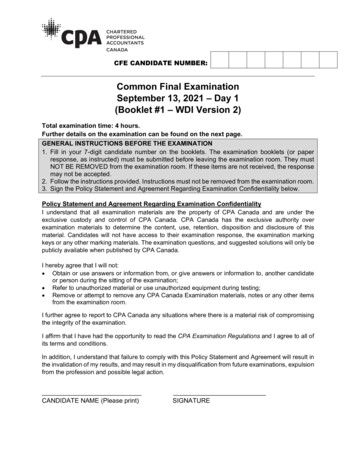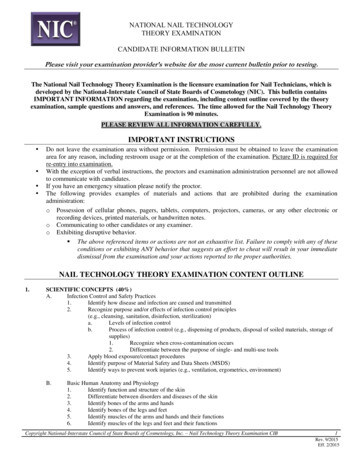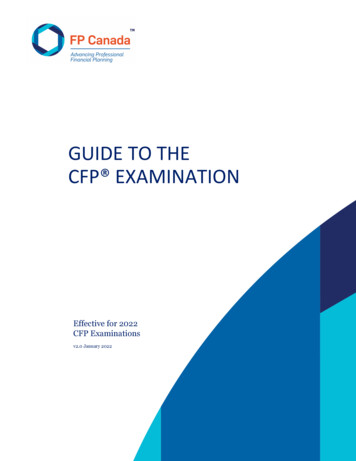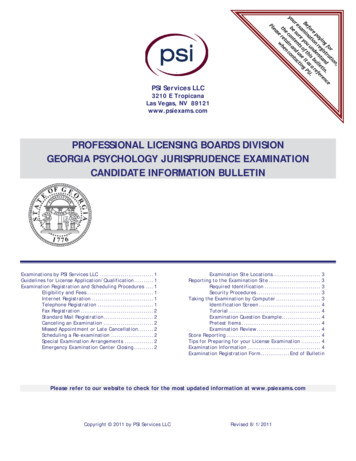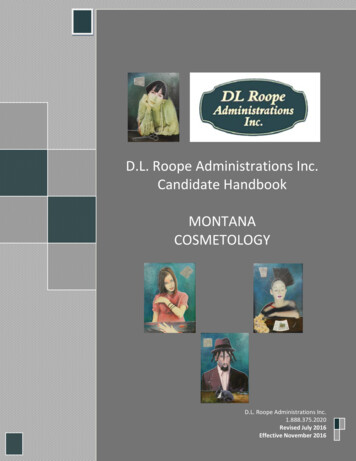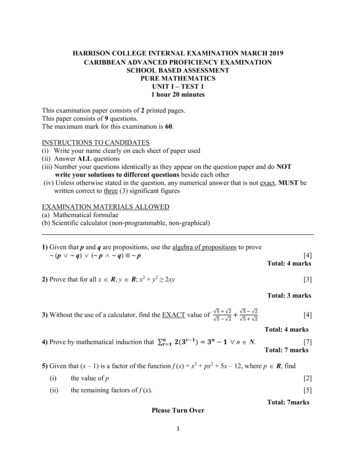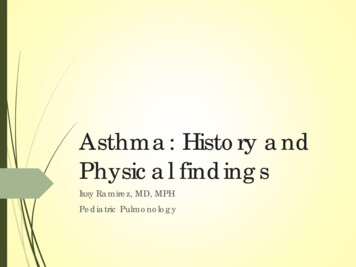
Transcription
Asthma: History andPhysical findingsIxsy Ramirez, MD, MPHPediatric Pulmonology
Key Symptom Indicators forConsideringa Diagnosis of Asthma Wheezing—high-pitched whistling sounds when breathing out. A lack of wheezing and a normal chest examination do not excludeasthma. History of any of the following: Cough (worse particularly at night) Recurrent wheeze Recurrent difficulty in breathing Recurrent chest tightness Lingering cough after a cold
Key Symptom Indicators forConsideringa Diagnosis of Asthma Symptoms occur or worsen in the presence of the following: Exercise Viral infection Inhalant allergens (eg, animals with fur or hair, house-dust mites, mold,pollen) Irritants (tobacco or wood smoke, airborne chemicals) Changes in weather Strong emotional expression (laughing or crying hard) Stress Menstrual cycles Symptoms occur or worsen at night, awakening the patient.
Medical History Symptoms Pattern of symptoms Precipitating and/or aggravating factors Development of infections and treatment Family history Social history History of exacerbations Effect of asthma on patient and family Assessment of patient’s and family’s perception of disease
Pattern of Symptoms Perennial, seasonal or both Continual, episodic or both Onset, duration, frequency Diurnal variations, especially nocturnal
Precipitating, Aggravating Factors Viral respiratory factors Change in weather Exercise Environmental allergens Smoking, smoke exposure Characteristic of home (carpet, basement, water leaks etc.) Environmental change (recent move, new pets etc.) Drugs (B-blockers, ASA) Pregnancy
Development of Disease &Treatment Age of onset and diagnosis History of early life injury to airways (CLD, pneumonia, parentalsmoking) Present management and response Adherence to use of medications Frequency of using SABA Need for oral corticosteroids and frequency of use
Family history Asthma Allergy Sinusitis Eczema Nasal polyps
Social History Daycare, workplace, school Social factors that interfere with adherence Social support
History of Exacerbations Usual prodromal of signs and symptoms Rapidity of onset Duration Frequency Severity (urgent care, ED, hospitalization) Life-threatening exacerbations Number and severity of exacerbations in the last year Usual pattern of management
Effect of Asthma on Patientand Family Number of days missed from school/work Limitation of activity History of nocturnal activity Effect on growth, development, behavior, school/workperformance Effect on family routines
Assessment of Patient’s andFamily’s Perception of Disease Knowledge of asthma and belief in the chronicity ofasthma and efficacy of treatment Perception and beliefs regarding use of long-termeffects of medications Ability to cope with disease Level of support Economic resources Sociocultural beliefs
Physical Examination The upper respiratory tract increased nasal secretions mucosal swelling nasal polyps The chest wheezing during normal breathing prolonged phase of forced exhalation hyperexpansion of the thorax use of accessory muscles The skin atopic dermatitis
Pulmonary Function Testing Additional pulmonary function studies may help ifthere are questions about COPD (diffusing capacity),a restrictive defect (measures of lung volumes), orVCD (evaluation of inspiratory flow-volume loops)
Pulmonary Function Testing Bronchoprovocation with methacholine, histamine,cold air, or exercise challenge may be useful whenasthma is suspected and spirometry is normal or nearnormal.
Pulmonary Function Testing
Vocal Cord Dysfunction
Common Diagnostic Challenges Asthma with coughing as the main symptom Cough can be the principal—or only—manifestation of asthma, especially inyoung children. Monitoring of PEF or bronchoprovocation may be helpful. Diagnosis is confirmed by a positive response to asthma medications. Vocal cord dysfunction can mimic asthma It is a distinct disorder. VCD may coexist with asthma. Asthma medications typically do not relieve VCD symptoms. Gastroesophageal reflux disease (GERD), obstructive sleep apnea (OSA),and allergic bronchopulmonary aspergillosis may coexist with asthmaand complicate diagnosis. Children ages 0 to 4 years. Diagnosis in infants and young children ischallenging and is complicated by the difficulty in obtaining objectivemeasurements of lung function in this age group. Use clinical history.
Monitoring Signs and Symptomsof Asthma Daytime asthma symptoms (including wheezing, cough, chesttightness, or shortness of breath) Nocturnal cough as a result of asthma symptoms Frequency of use of SABA for relief of symptoms Inability or difficulty performing normal activities (includingexercise) because of asthma symptoms
Monitoring Signs and Symptomsof Asthma
Monitoring pulmonary function Spirometry Peak flow monitoring Peak flow vs. symptom-based monitoring action plan
Monitoring PulmonaryFunction
Monitoring Quality of Life Any work or school missed because of asthma Any reduction in usual activities (eitherhome/work/school or recreation/exercise) Any disturbances in sleep due to asthma Any change in caregivers’ activities due to a child’sasthma (for caregivers of children who have asthma)
Monitoring Quality of Life
Monitoring Quality of Life
Monitoring History of AsthmaExacerbations The most common cause of severe exacerbations is infectionwith a respiratory virus, especially rhinovirus, but exacerbationsmay be brought on by exposures to allergens or irritants, airpollutants, certain medications, and, possibly, emotional stress. Exacerbations also can be triggered by withdrawal of ICS orother long-term-control therapy.
Monitoring History of AsthmaExacerbations It is important to evaluate the frequency, rate of onset, severity,and causes of exacerbations A history of previous exacerbations, especially in the past year, isthe strongest predictor of future severe exacerbations leading toED visits and hospitalizations
Monitoring History of AsthmaExacerbations Severity of the exacerbation can be estimated by theincreased need for oral corticosteroids Any hospitalizations should be documented, including thefacility, duration of stay, and any use of critical care orintubation. To facilitate continuity of care, the clinician thencan request summaries of all care received
Monitoring History of AsthmaExacerbations
Follow up See patients every 3 to 6 months for follow up or morefrequently with exacerbations Adjust controllers if needed based on exacerbations.
Medical History Symptoms Pattern of symptoms . Frequency of using SABA Need for oral corticosteroids and frequency of use. Family history Asthma Allergy Sinusitis Eczema Nasal polyps. Social History Daycare, workplace, school Social factors that interfere with adherence Social support. History of Exacerbations Usual prodromal of signs and .
